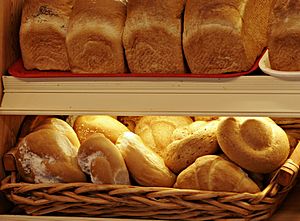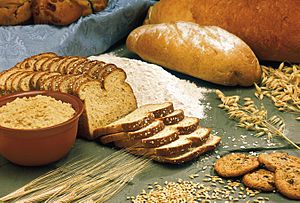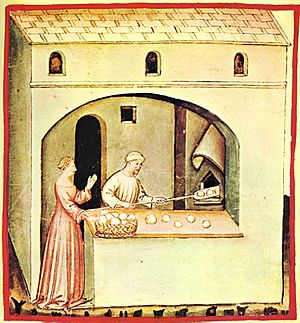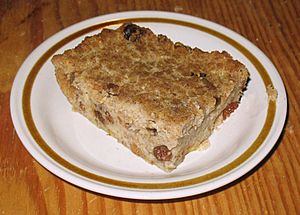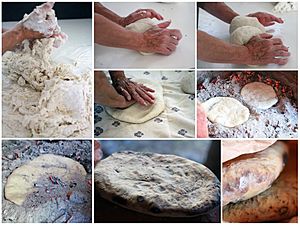Bread facts for kids
Bread is a popular food that is usually baked. It is mainly made from dough, which is a mix of flour and water. Most bread also includes salt and yeast. It is often cooked in an oven.
You can toast bread or use it to make sandwiches. Foods like Pizza are also based on bread. There are many different kinds of bread around the world.
There are two main types of bread:
- Leavened bread is made by adding yeast or other things that make the dough rise. The yeast creates gas, which makes the dough light and fluffy. This type of bread can be baked into large loaves. It is commonly eaten in Europe, America, and many parts of Asia.
- Unleavened flatbread is made from just flour and water, with no yeast. It is baked in flat, thin shapes, like a tortilla or chapati. This bread cannot be made thick because it would be too heavy to eat. Unleavened bread is popular in the Middle East, Africa, parts of Asia, and Central America. It can be baked on a hot plate, stone, or in an oven.
The color and taste of bread change based on the type of flour used and how it is baked. Flour made from the whole grain gives darker bread. Flour from just the inside of the wheat grain makes very white bread. Flours like rye and barley also make darker breads. The type of flour can also affect how long the bread stays fresh.
Contents
History of Bread
Bread is one of the oldest foods ever made. People found signs of starch on rocks from 30,000 years ago in Europe. This suggests that early humans might have cooked a simple flatbread from plant roots over a fire.
Around 10,000 BC, when farming began, grains became the main ingredient for bread. Yeast spores are everywhere, even on grain surfaces. This means that if dough was left out, it would naturally rise.
Early bakers found different ways to make bread rise. They could leave dough exposed to the air to catch wild yeasts. People in ancient Gaul and Iberia used foam from beer to make their bread lighter. In places where people drank wine, they used a mix of grape juice and flour that had started to ferment. Often, bakers would save a piece of dough from the day before to use as a "starter" for new bread.
In 1961, the Chorleywood bread process was created. This method uses strong mixing to make dough rise much faster. This means bread can be made very quickly and cheaply in large factories. However, some people worry that this process might reduce the bread's nutritional value.
How Bread is Used
Bread can be eaten at different temperatures. After baking, it can be toasted. Most often, bread is eaten with your hands, either by itself or with other foods. You can dip bread into liquids like gravy or soup. It can also be topped with sweet or savory spreads. Bread is also used to make sandwiches with meats, cheeses, and vegetables.
Bread is also an ingredient in other dishes. For example, breadcrumbs are used to make crunchy crusts or thicken sauces. Bread is also used in sweet or savory bread puddings, or as a binder in sausages.
Bread and Nutrition
Bread is a good source of grains in your diet. In the USA, one slice of white bread is usually counted as one ounce. Bread, especially whole grain bread, gives you carbohydrates, which are energy. It also has important nutrients like magnesium, iron, selenium, B vitamins, and dietary fiber.
The Bread Crust
The crust of bread forms on the outside during baking. It gets hard and brown because of a chemical reaction called the Maillard reaction, which uses sugars and amino acids on the surface. The crust is usually harder and has a stronger flavor than the inside of the bread.
Some old stories say that eating bread crust makes your hair curly, but this is not true. It is also rumored to be healthier. Some studies have shown that the crust can have more dietary fiber and antioxidants.
How Bread is Made
Doughs are usually baked. But in some cultures, breads are steamed (like mantou), fried (like puri), or cooked on a dry frying pan (like tortillas). Bread can be made to rise (leavened) or not (unleavened), like matzo.
Common ingredients include salt, fat, and things that make it rise, like yeast and baking soda. Other ingredients can be added too, such as milk, eggs, sugar, spices, fruit (like raisins), vegetables (like onions), nuts (like walnuts), or seeds (like poppy seeds).

Ingredients and Recipes
Professional bakers use a special way to write recipes called "baker's percentage." The amount of flour is always 100%, and all other ingredients are shown as a percentage of the flour's weight. Measuring by weight is more exact than by volume.
The amount of water compared to flour is very important. It changes how the bread feels and looks inside. Hard wheat flours soak up more water than softer ones. Most special artisan breads have a lot of water, from 60% to 75%. More water in yeast breads means more gas bubbles and a coarser inside texture.
Flour in Bread
Flour is grain ground into a powder. It gives the bread its main structure, starch, and protein. The amount of protein in flour is a good sign of how good the bread dough and final bread will be. While you can use all-purpose flour, a special bread flour with more protein (12–14%) is better for high-quality bread.
Wheat flour has starch and different types of protein. When flour is mixed with water, some proteins dissolve. The other proteins, glutenin and gliadin, form a network called gluten. This gluten network gives bread its stretchy texture. Kneading the dough helps this gluten develop.
Liquids in Bread
Water or another liquid is used to turn flour into dough. The amount of liquid needed changes with each recipe. For yeast breads, a common ratio is 3 parts liquid to 5 parts flour. Some recipes use a lot more liquid, especially if steam is the main way the bread rises.
Instead of water, recipes might use milk or other dairy products like buttermilk or yogurt. They can also use fruit juice or eggs. These liquids add sweetness, fats, or help the bread rise, along with providing water.
Fats in Bread
Fats like butter, vegetable oils, or lard affect how gluten develops. They coat the protein strands, making them smoother. Fats also help hold the bread's structure together. If too much fat is used, the protein structures can separate. About 3% fat by weight seems to help the bread rise the most. Fats also make bread softer and help it stay fresh longer.
Bread Improvers
Bread improvers are often used in commercial bakeries. They help reduce the time needed for dough to rise and improve the bread's texture and size. These can be things that strengthen the dough or make it easier to slice.
Salt is often added to make bread taste better and to control how active the yeast is. It also helps the inside texture of the bread by making the gluten stronger. Some bakers wait to add salt until after the dough has rested for a while.
How Bread Rises (Leavening)
Leavening is the process of adding gas to dough before or during baking. This makes the bread lighter and easier to chew. Most bread eaten in Western countries is leavened.
Chemical Leavening
One simple way to make bread rise is by using chemicals that produce gas.
- You can use baking powder or a self-raising flour that already has baking powder in it.
- Another way is to add an acidic ingredient like buttermilk and then add baking soda. The reaction between the acid and soda creates gas.
Breads made this way are called quick breads or soda breads. This method is common for muffins, pancakes, and banana bread.
Yeast Leavening
Many breads rise because of yeast. The most common yeast used for bread is Saccharomyces cerevisiae, which is also used to make alcoholic drinks. This yeast eats some of the carbohydrates and sugar in the flour, producing carbon dioxide gas.
Commercial bakers often use specially made baker's yeast. This yeast gives reliable and quick results because it is a pure type. Many artisan bakers grow their own yeast cultures, which can be used for many years if cared for properly.
The process for yeast and sourdough breads is similar. Water, flour, salt, and the leavening agent are mixed. Other ingredients like spices or fruits can be added. The dough is then allowed to rise one or more times. A longer rising time often means more flavor. After rising, the dough is shaped into loaves and baked in an oven.
Many breads are made with a "straight dough," where all ingredients are mixed at once. Other breads use a "pre-ferment," where some flour, water, and the leavening agent are mixed a day before and allowed to ferment overnight. The next day, the rest of the ingredients are added. This method often creates a more flavorful bread with a better texture.
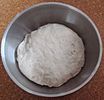 |
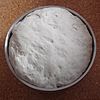 |
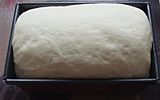 |
| Before first rising | After first rising | After proofing, ready to bake |
Sourdough Bread
Sourdough is a type of bread made by a long fermentation of dough. It uses natural yeasts and bacteria called lactobacilli. It usually has a slightly sour taste because of the lactic acid produced by these bacteria.
Sourdough breads are made with a "sourdough starter." This starter grows yeast and lactobacilli in a mix of flour and water. It uses microorganisms already found on flour, so you don't need to add extra yeast. A starter can be kept alive for a very long time by adding more flour and water regularly. Some bakers have starters that are many generations old, which they believe give their bread a special taste.
In the past, all yeast-leavened breads were sourdoughs. Today, sourdough bread has become popular again in artisan bakeries.
Steam Leavening
When bread bakes, the water inside turns into steam very quickly. This steam expands and makes the bread rise. This happens even if other leavening agents are used. The heat turns the water from the inside of the dough's bubbles into steam. This steam expands and helps the bread get bigger. This is the main reason bread rises once it is in the oven. The heat also stops the yeast or bacteria from producing more gas.
Bacterial Leavening
Salt-rising bread uses bacteria to make it rise, instead of yeast. This method can be tricky, but the bread is known for its cheese-like flavor and fine texture.
Aerated Bread
In the past, especially in the United Kingdom, some bread was made by forcing carbon dioxide gas into the dough under pressure. This was called "aerated bread." The Aerated Bread Company made and sold this type of bread from the mid-1800s to the mid-1900s.
Religious Breads
Bread is important in the Christian and Jewish religions.
- Jewish people eat unleavened bread, called matzo, during Passover.
- The Catholic celebration of the Eucharist uses unleavened wafers.
- Orthodox churches use leavened bread for the Eucharist. They see it as a symbol of the New Testament. This difference was one reason for the split between Eastern and Western churches in 1054.
Types of Bread
- Bagels
- Baguettes
- Croissants
- Lavash
- Markouk in Lebanon and the Levant
- Matzo in all Jewish communities
- Naan bread
- North American biscuits
- Pitas
- Pizza dough
- Pretzels
- Scones
- Tortillas
Bread is a very important food in many countries and cultures. It is so important that it is even part of some religious rituals.
Cake is made in a similar way to bread. However, sugar, fat, and milk are added to the dough, often with more ingredients.
Images for kids
-
Sangak, an Iranian flatbread
-
Small home made bread with pumpkin and sunflower seeds
-
A Ukrainian woman in national dress welcoming with bread and salt
See also
 In Spanish: Pan para niños
In Spanish: Pan para niños


